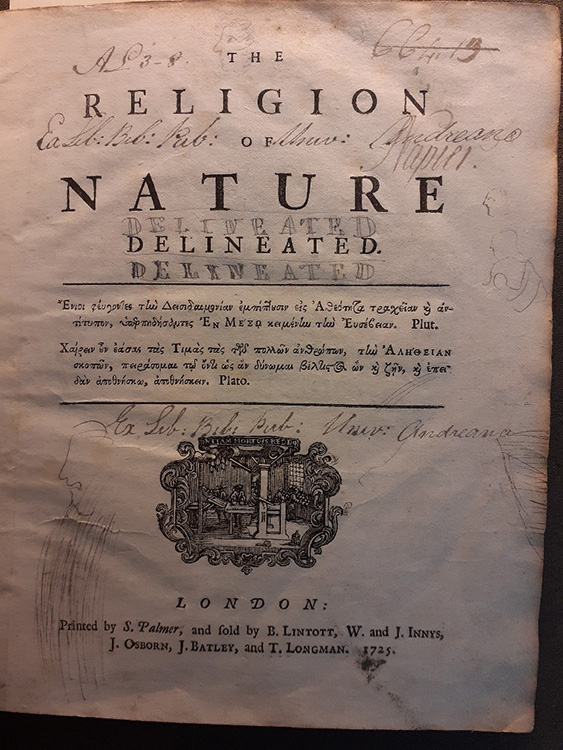Benjamin Franklin as Printer
Beth Dumas, Rare Books Cataloguer and a US citizen, takes a look at a fellow-countryman of note!
When Joe Biden took office as President of the United States this January, one of the first things he did was redecorate the Oval Office. In one key move, he replaced the portrait of Andrew Jackson, a populist who infamously ordered the removal of thousands of Native Americans from their homelands, with a portrait of Benjamin Franklin (1706-90). Franklin’s extraordinary life took him all over the American colonies, Great Britain, and France, but he also believed in a ‘Republic of Letters’, or a community formed across international, religious, and class boundaries in pursuit of scientific and philosophic exploration. The University of St Andrews, as an institution of academic enquiry, firmly believed in Franklin’s mission and granted him an honorary doctorate in 1759, in honour of his work on electricity. See our blog from 2017 which includes some of his connections with St Andrews.
But before he was a global celebrity, he was a printer. Franklin began as an apprentice under his older brother in Boston, but eventually ran away to Philadelphia to seek new opportunities. He came to the attention of Pennsylvania’s Governor Keith, who claimed that if Franklin went to London to procure printing equipment, his credit would bankroll the endeavour. So Franklin, at the age of 18, arrived in London on Christmas Eve 1724. Unfortunately, Keith’s promise of financial support was unfulfilled, and Franklin was forced to seek work on his own. He writes in his Autobiography that he found work with Samuel Palmer, a London printer, in January of 1725. Then, from November 1725 to June 1726 he was employed at a much larger printing house owned by John Watts. He then returned to Philadelphia to establish his own business.
While working at Palmer’s, in 1725, Franklin writes, he ‘was employed in composing for the second edition of Wolllaston’s Religion of Nature.’ This is the only book he mentions by name, and, in fact, he was slightly wrong. He actually composed the third edition, as the work was privately circulated in manuscript in 1722 and first published in 1724. Franklin clearly found the material he was setting in type to be of interest, as he wrote and printed a brief reply, entitled A Dissertation on Liberty and Necessity, Pleasure and Pain. Franklin claimed to regret writing it, however, and to this day the text is incredibly rare.

However, Wollaston’s third edition can be found in the library of the University of St Andrews, which Franklin had a hand in typesetting. It is found at classmark ‘s B1395.R4’. It is very possible that the edition arrived as part of the Copyright Deposit scheme, which entitled St Andrews along with other institutions throughout Great Britain to claim a copy of any book registered at Stationers’ Hall in London. The St Andrews copy has been well used, as represented by the title page shown here.
But that’s not the only work composed or pressed by Franklin between 1725-26 available in the University Library. Five other works held in Special Collections can also be linked to either Palmer’s or Watts’ printing houses during Franklin’s tenure. They are as follows:
- Vida’s Art of Poetry, 1725. (s PN1040.V4)
- Miscellaneous Works, in Verse and Prose, of the Late Right Honourable Joseph Addison, Esq, (s PR3300.D26)
- Epistola Critica ad Eruditissimim Virum H.B.S.E.I., (s AC995.P25)
- The Supplement to Antiquity Explained… (sf DE57.M7H8)
- The Universal Passion. (rf PR1230.Z8D8(SR))
Franklin’s description of his time in London is one of the best descriptions of an 18th century printing house, and allows the reader to imagine what sort of lifestyle the printers who made the books would have led. He seems to take greatest issue with the drinking habits of his colleagues, and provides the illustrative example:
‘My companion at the press drank every day a pint before breakfast, a pint at breakfast with his bread and cheese, a pint between breakfast and dinner, a pint at dinner, a pint in the afternoon about six o’clock, and another when he had done his day’s work’.
Franklin, who claims that he drank only water at work, was thereby a prized employee who could make quick work of composing.
So the connection between Benjamin Franklin and the University of St Andrews is not just in his middle years, but indeed includes his youthful work. Although eventually he moved on from printing to his more famous jobs as scientist and statesman, it’s good to remember that even he had to start somewhere, and his first foray into a ‘Republic of Letters’ was as an anonymous pressman.
Beth Dumas
Rare Books Cataloguer
Franklin, B., 2010. The Autobiography of Benjamin Franklin. [ebook] Philadelphia: University of Pennsylvania Press. Available at: <https://doi.org/10.9783/9780812200119> [Accessed 4 March 2021].
Wilkinson, H., 2016. Benjamin Franklin’s London Printing 1725-26. Papers of the Bibliographical Society of America, 110(2), pp.139-180.